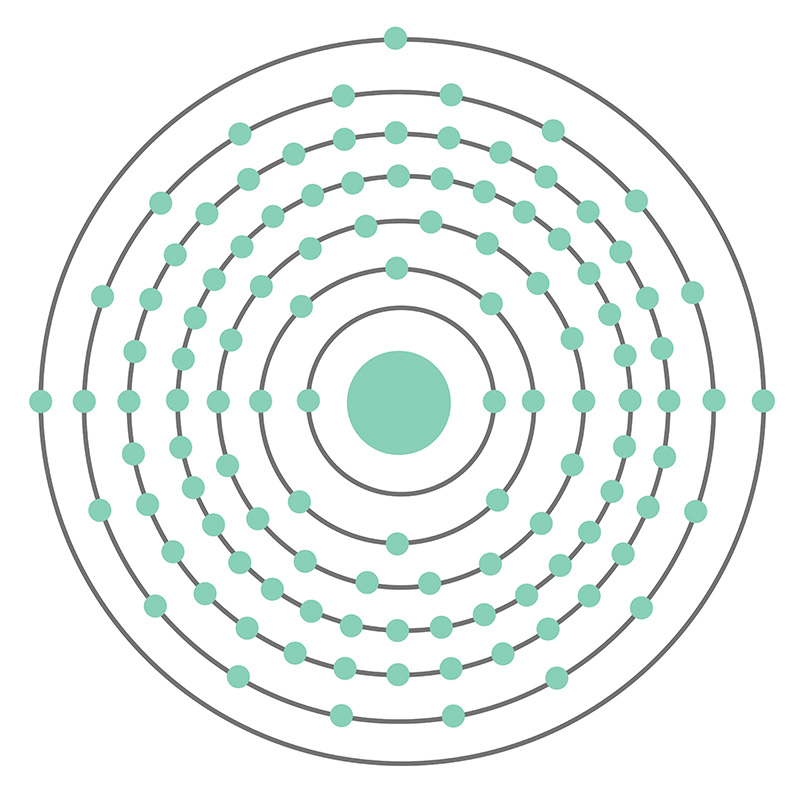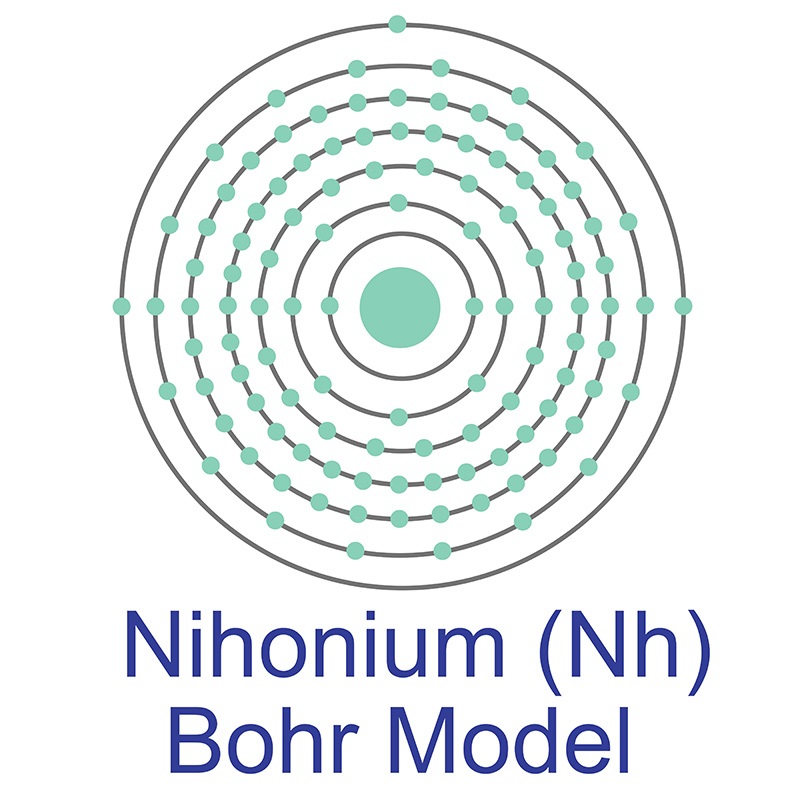About Nihonium

Nihonium (Nh), formerly known as Ununtrium (Uut), is a p-block transactinide element with atomic number 113. Synthesis of ununtrium was first claimed in 2003 by collaborating teams at the Joint Institute for Nuclear Research in Dubna, Russia and the Lawrence Livermore National Laboratory in Livermore, California, USA. However, in 2015 the IUPAC formally accepted the element's discovery by a team at the RIKEN institute in Japan led by Kosuke Morita, marking the only element officially discovered in Asia. To synthesize the superheavy element, the RIKEN team bombarded a curium target with sodium ions to initiate a chain of decay reactions beginning with 266Bh.
The RIKEN physicists bestowed the name Nihonium (symbol: Nh) in honor of the Japanese version of the country's name. After a six month review period, the name became permanent in December 2016.
Nihonium Properties
 Nihonium (Ununtrium) is a P-Block, Group 13, Period 7 element. The number of electrons in each of Nihonium's shells is 2, 8, 18, 32, 32, 18, 3 and its electron configuration is [Rn] 5f14 6d10 7s27p1. In its elemental form, Nihonium's CAS number is 54084-70-7. Nihonium was discovered in 2003 by the Joint Institute for Nuclear Research in Dubna, Russia and the Lawrence Livermore National Laboratory in Livermore, California, USA. Nihonium is a synthetic element that is not present in the environment. Little is known about the element, its appearance is unknown, and it has no known uses.
Nihonium (Ununtrium) is a P-Block, Group 13, Period 7 element. The number of electrons in each of Nihonium's shells is 2, 8, 18, 32, 32, 18, 3 and its electron configuration is [Rn] 5f14 6d10 7s27p1. In its elemental form, Nihonium's CAS number is 54084-70-7. Nihonium was discovered in 2003 by the Joint Institute for Nuclear Research in Dubna, Russia and the Lawrence Livermore National Laboratory in Livermore, California, USA. Nihonium is a synthetic element that is not present in the environment. Little is known about the element, its appearance is unknown, and it has no known uses.
Nihonium information, including properties, research, applications and other useful facts are discussed below. Scientific facts such as the atomic structure, ionization energy, abundance on Earth, conductivity and thermal properties are included.
| Symbol: |
Nh |
| Atomic Number: |
113 |
| Atomic Weight: |
286 |
| Element Category: |
post-transition metal |
| Group, Period, Block: |
13, 7, p |
| Color: |
silvery-gray/ unknown |
| Other Names: |
Ununtrium |
| Melting Point: |
430 °C, 810°F, 700 K (predicted) |
| Boiling Point: |
1100 °C, 2000 °F, 1400 K |
| Density: |
18 g·cm3 (predicted) |
| Liquid Density @ Melting Point: |
N/A |
| Density @ 20°C: |
11.85 g/cm3 |
| Density of Solid: |
16000 (predicted) kg·m3 |
| Specific Heat: |
N/A |
| Superconductivity Temperature: |
N/A |
| Triple Point: |
N/A |
| Critical Point: |
N/A |
| Heat of Fusion (kJ·mol-1): |
N/A |
| Heat of Vaporization (kJ·mol-1): |
N/A |
| Heat of Atomization (kJ·mol-1): |
N/A |
| Thermal Conductivity: |
N/A |
| Thermal Expansion: |
N/A |
| Electrical Resistivity: |
N/A |
| Tensile Strength: |
N/A |
| Molar Heat Capacity: |
N/A |
| Young's Modulus: |
N/A |
| Shear Modulus: |
N/A |
| Bulk Modulus: |
N/A |
| Poisson Ratio: |
N/A |
| Mohs Hardness: |
N/A |
| Vickers Hardness: |
N/A |
| Brinell Hardness: |
N/A |
| Speed of Sound: |
N/A |
| Pauling Electronegativity: |
N/A |
| Sanderson Electronegativity: |
N/A |
| Allred Rochow Electronegativity: |
N/A |
| Mulliken-Jaffe Electronegativity: |
N/A |
| Allen Electronegativity: |
N/A |
| Pauling Electropositivity: |
N/A |
| Reflectivity (%): |
N/A |
| Refractive Index: |
N/A |
| Electrons: |
113 |
| Protons: |
113 |
| Neutrons: |
173 |
| Electron Configuration: |
[Rn] 5f14 6d10 7s27p1 |
| Atomic Radius: |
170 pm (predicted) |
Atomic Radius,
non-bonded (Å): |
Unknown |
| Covalent Radius: |
136 pm (predicted) |
| Covalent Radius (Å): |
1.36 |
| Van der Waals Radius: |
N/A |
| Oxidation States: |
1, 2, 3, 5 (predicted) |
| Phase: |
Solid (predicted) |
| Crystal Structure: |
unknown |
| Magnetic Ordering: |
unknown |
| Electron Affinity (kJ·mol-1) |
Unknown |
| 1st Ionization Energy: |
704.9 kJ·mol-1 (estimated) |
| 2nd Ionization Energy: |
N/A |
| 3rd Ionization Energy: |
N/A |
| CAS Number: |
54084-70-7 |
| EC Number: |
N/A |
| MDL Number: |
N/A |
| Beilstein Number: |
N/A |
| SMILES Identifier: |
N/A |
| InChI Identifier: |
N/A |
| InChI Key: |
N/A |
| PubChem CID: |
N/A |
| ChemSpider ID: |
N/A |
| Earth - Total: |
N/A |
| Mercury - Total: |
N/A |
| Venus - Total: |
N/A |
| Earth - Seawater (Oceans), ppb by weight: |
N/A |
| Earth - Seawater (Oceans), ppb by atoms: |
N/A |
| Earth - Crust (Crustal Rocks), ppb by weight: |
N/A |
| Earth - Crust (Crustal Rocks), ppb by atoms: |
N/A |
| Sun - Total, ppb by weight: |
N/A |
| Sun - Total, ppb by atoms: |
N/A |
| Stream, ppb by weight: |
N/A |
| Stream, ppb by atoms: |
N/A |
| Meterorite (Carbonaceous), ppb by weight: |
N/A |
| Meterorite (Carbonaceous), ppb by atoms: |
N/A |
| Typical Human Body, ppb by weight: |
N/A |
| Typical Human Body, ppb by atom: |
N/A |
| Universe, ppb by weight: |
N/A |
| Universe, ppb by atom: |
N/A |
| Discovered By: |
Joint Institute for Nuclear Research and Lawrence Livermore National Laboratory |
| Discovery Date: |
2003 |
| First Isolation: |
N/A |
Nihonium Isotopes
Nihonium is an artificial element. Like all artificial elements, it has no stable isotopes.
| Nuclide |
Isotopic Mass |
Half-Life |
Mode of Decay |
Nuclear Spin |
Magnetic Moment |
Binding Energy (MeV) |
Natural Abundance
(% by atom) |
| 278Nh | 278.17058(20)# | 340 µs | α to 274Rg | N/A | N/A | N/A | - |
| 282Nh | 282.17567(39)# | 73 ms | α to 278Rg | N/A | N/A | N/A | - |
| 283Nh | 283.17657(52)# | 100(+490-45) ms | α to 279Rg | N/A | N/A | N/A | - |
| 284Nh | 284.17873(62)# | 0.48(+58-17) s | α to 280Rg | N/A | N/A | N/A | - |
| 285Nh | 285.17973(89)# | 5.5 s | α to 281Rg | N/A | N/A | N/A | - |
| 286Nh | 286.18221(72)# | 19.6 s | α to 282Rg | N/A | N/A | N/A | - |

 Nihonium (Ununtrium) is a P-Block, Group 13, Period 7 element. The number of electrons in each of Nihonium's shells is 2, 8, 18, 32, 32, 18, 3 and its electron configuration is [Rn] 5f14 6d10 7s27p1. In its elemental form, Nihonium's CAS number is 54084-70-7. Nihonium was discovered in 2003 by the Joint Institute for Nuclear Research in Dubna, Russia and the Lawrence Livermore National Laboratory in Livermore, California, USA. Nihonium is a synthetic element that is not present in the environment. Little is known about the element, its appearance is unknown, and it has no known uses.
Nihonium (Ununtrium) is a P-Block, Group 13, Period 7 element. The number of electrons in each of Nihonium's shells is 2, 8, 18, 32, 32, 18, 3 and its electron configuration is [Rn] 5f14 6d10 7s27p1. In its elemental form, Nihonium's CAS number is 54084-70-7. Nihonium was discovered in 2003 by the Joint Institute for Nuclear Research in Dubna, Russia and the Lawrence Livermore National Laboratory in Livermore, California, USA. Nihonium is a synthetic element that is not present in the environment. Little is known about the element, its appearance is unknown, and it has no known uses.